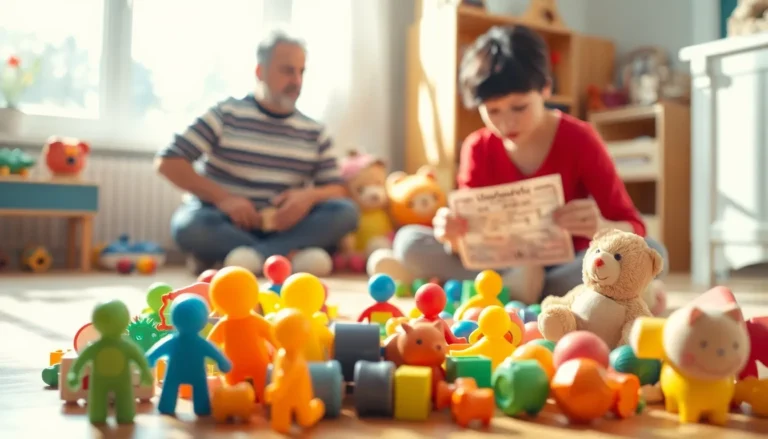In a world buzzing with distractions, staying focused can feel like trying to catch a greased pig at a county fair. For those with ADHD, this challenge can be especially daunting. But what if there was a way to tame that chaos and find a little peace in the pandemonium? Enter mindfulness—a powerful tool that can help individuals with ADHD harness their thoughts and channel their energy more effectively.
Mindfulness isn’t just for yogis in serene poses; it’s for anyone looking to create a little calm amidst the storm. By practicing mindfulness, individuals can learn to observe their thoughts without judgment and cultivate a greater sense of awareness. It’s like having a mental pause button, allowing them to hit reset and regain control over their racing minds. So, let’s dive into how mindfulness can transform the ADHD experience from overwhelming to manageable, one breath at a time.
Table of Contents
ToggleUnderstanding ADHD
ADHD significantly impacts attention, self-control, and behavior. It’s a neurodevelopmental disorder that affects both children and adults, leading to various challenges in daily life.
What Is ADHD?
ADHD stands for Attention-Deficit/Hyperactivity Disorder. This condition is characterized by persistent patterns of inattention, hyperactivity, and impulsivity. Diagnosis typically occurs in childhood, though symptoms may continue into adulthood. Individuals with ADHD often struggle with focus, time management, and organization. Research indicates that approximately 5% of children and 2.5% of adults experience ADHD, showcasing its reach across age groups.
Symptoms of ADHD
Symptoms of ADHD generally fall into two categories: inattention and hyperactivity-impulsivity. Signs of inattention include difficulty sustaining attention in tasks and failing to follow through on instructions. Hyperactivity symptoms may manifest as excessive movement and fidgeting. Impulsivity may cause interruptions in conversations and difficulty waiting for one’s turn. According to the CDC, these symptoms can interfere with relationships, academic performance, and daily functioning. Identifying these symptoms early leads to better management strategies, enhancing the quality of life for individuals with ADHD.
The Concept of Mindfulness

Mindfulness offers a powerful approach for individuals facing challenges with ADHD. It involves maintaining awareness of the present moment, focusing on thoughts and feelings without judgment.
Definition of Mindfulness
Mindfulness refers to the mental state achieved by focusing on the present. It encourages individuals to pay attention to their thoughts, emotions, and sensations in a non-reactive manner. This practice allows people to observe their experiences, promoting a deeper understanding of their mind’s workings. Techniques such as meditation, deep breathing, and guided imagery often facilitate mindfulness. Awareness of the present enables individuals to step back from distracting thoughts, making it a useful strategy for managing ADHD symptoms.
Benefits of Mindfulness
Mindfulness provides numerous benefits, particularly for those with ADHD. Enhanced focus and improved attention span are among the key advantages. Participants often experience reduced anxiety and increased emotional regulation. Studies indicate that consistent mindfulness practice can help decrease impulsivity, leading to better decision-making. Furthermore, mindfulness cultivates a sense of calm, allowing individuals to feel less overwhelmed by racing thoughts. Engaging in mindfulness exercises regularly promotes overall well-being, making daily challenges more manageable.
Mindfulness Techniques for ADHD
Implementing mindfulness techniques can enhance focus and emotional control for individuals with ADHD. Various practices exist that foster present-moment awareness and promote relaxation.
Mindful Breathing
Mindful breathing centers attention on the breath, encouraging calmness. Practicing this technique involves inhaling slowly through the nose, holding for a moment, and exhaling through the mouth. Breathing exercises can decrease anxiety and reduce racing thoughts. Engaging in mindful breathing for a few minutes daily supports concentration and stability during challenging tasks. Focus shifts from distractions to the rhythm of breathing, grounding individuals in the present.
Body Scan Meditation
Body scan meditation cultivates awareness of bodily sensations. This practice starts by lying down in a comfortable position and directing focus to different body parts, beginning from the toes and moving to the head. By observing sensations without judgment, individuals learn to recognize tension and relaxation. Regularly practicing body scans can enhance self-awareness and improve emotional regulation. Connecting the mind and body through this meditation aids in identifying physical signs of stress related to ADHD.
Mindful Observation
Mindful observation encourages individuals to engage with their surroundings without immediate judgment. This technique invites attention to everyday experiences, such as sounds, colors, and textures, fostering curiosity. Observing the environment without distraction can elevate focus and clarity. Practicing this technique for a few minutes strengthens attention capabilities. Participants learn to appreciate details in their surroundings, allowing for an increased presence in daily life.
Implementing Mindfulness in Daily Life
Mindfulness can easily integrate into daily routines, enhancing focus and emotional regulation for individuals with ADHD. Developing a structured approach ensures consistent practice.
Creating a Mindfulness Routine
Establishing a mindfulness routine starts with selecting a specific time for practice. Mornings often suit many individuals, providing a calm start to the day. Engaging in brief sessions, lasting five to ten minutes, can be effective. Focusing on respiration or body awareness promotes grounding. Consistency leads to a greater sense of control over thoughts and feelings. Gradually extending the duration can deepen the practice, encouraging persistence and commitment.
Using Mindfulness Apps
Mindfulness apps simplify access to mindfulness practices. Numerous options exist, with features such as guided meditations and progress tracking. Popular apps like Headspace and Calm offer tailored sessions for various needs. Users can explore themes like stress reduction or improved focus. Features include reminders to encourage regular engagement. Taking advantage of these digital tools supports incorporating mindfulness into everyday activities.
Embracing mindfulness can significantly enhance the lives of individuals with ADHD. By fostering present-moment awareness and emotional regulation, mindfulness transforms daily challenges into manageable experiences. Regular practice of techniques like mindful breathing and body scan meditation can lead to improved focus and reduced impulsivity.
Integrating mindfulness into daily routines not only supports individuals in navigating their symptoms but also empowers them to regain control over their thoughts and feelings. With the right tools and commitment, mindfulness offers a pathway to a more balanced and fulfilling life for those affected by ADHD.





